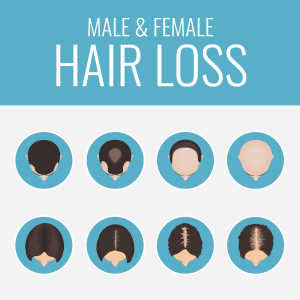
A hair transplant is a surgical procedure used to treat baldness or hair loss. Transplants can also be done to replace hair lost due to injury, burns, or scalp disease. Two other terms that are used for hair transplant are “Hair Restoration” and “Hair Replacement”. The surgery involves a plastic or dermatological surgeon to remove healthy hair bearing skin from one area of the scalp and transferring the grafts (small pieces of skin) to the hairless parts of the scalp. The area that the hair is being removed from is called the “donor site” and the area of the body that the hair is being relocated to is called the “recipient site”. There are several types of hair transplant methods: Direct Hair Implantation (DHI), Follicular Unit Transplant (FUT), Follicular Unit Extraction (FUE), Neo Graft, ARTAS, and Scalp Micropigmentation (SMP).
During Direct Hair Implantation, they use a specialized pen-shaped tool that can do both at the same time. DHI is a modified version of FUE hair implantation and follows a similar procedure. Your surgeon will remove hair follicles from a part of your scalp, usually the back of your head, and implant them into balding areas. These hair follicles will eventually grow new hairs.
Here is what you can generally expect during the DHI procedure:
- Your surgeon will shave your head and apply local anesthesia to numb it.
- The surgeon will extract hair follicles from the back of your head using a tool with a fine tip.
- The hair follicles will be loaded into a pen-shaped tool and implanted into the balding part of your scalp.
- The surgeon will apply an antibiotic cream and apply a bandage to all sites.
In Follicular Unit Extraction, a surgeon manually cuts channels in your scalp before implanting hair follicles. A FUE procedure involves the individual extraction of hair follicles from the (donor site), which are then transplanted to another area on the scalp (recipient site).
Some advantages of Follicular Unit Extraction are:
- Minimal recovery time of only one day
- No stitches required
- Repeat visits aren’t necessary for removal of stitches
- Shorter healing time
- Very small and minimal scars over the donor areas
Some disadvantages of Follicular Unit Extractions are:
- Procedure is more expensive
- Shaving is required
- A second procedure can’t be done in the future
- The operative time is long
- Difficult for larger areas
- The number of grafts extracted per day are limited (severe baldness requires multiple sessions)
FUE and DHI surgeries generally take about 8 hours to complete, but the exact time can vary depending on the number of hair follicles being transplanted. It can take 12 to 18 months to see the full results of the surgery.
A Follicular Unit Transplant procedure involves removing a long section of the scalp from the (donor site), separating the hair follicles, and then transplanting them to the (recipient site).
Some advantages of Follicular Unit Transplant are:
- Shorter operative time
- FUE can be performed afterwards if needed, but not vice versa
- Repeat procedure can be done in the future
- Surgery is conducted under microscopy
- Shaving is not required
Some disadvantages of Follicular Unit Transplant are:
- The procedure may leave a scar
- Longer healing time
- Stitches may be required
- More discomfort
For patients who may have a limited budget, Follicular Unit Transplant may be the best option because of the lower cost and will still give you the outstanding results that you desire. The cost of Follicular Unit Extraction is the more expensive of the two methods. The better of the two methods is the one that works best to meet your individual needs and the recommendations of your physician.
A popular new technique and the most advanced in the hair transplantation industry is called Neo Graft. The Neo Graft system is the first FDA cleared follicular unit harvesting and implantation system. This procedure is minimally invasive and is designed to help you improve your baldness without the post-surgery discomfort, long scars, and the long recovery time of a traditional hair transplant. The Neo Graft technique is a semi-automated version of the FUE technique. This system uses pneumatic controls to precisely extract complete individual hair follicles from the backs and sides of the head, which are then transplanted to the bald areas of the scalp. Unlike the FUE technique which requires the surgeon to make several incisions in your scalp before implanting the new hairs, the Neo Graft technique uses a device that automatically removes hair follicles by extraction with suction and then implantation into the thinning areas to restore fullness and ensure a natural hair growth pattern.
Some other benefits of Neo Graft include:
-
- No general anesthesia required
- No stiches or staples are used in the procedure
- Fewer restrictions on your daily activities
- Fewer complications
- Quicker than FUE (Follicular Unit Extraction)
- Reduced hair follicle damage
The ARTAS robotic hair restoration system is also one of the newer trends in hair transplant surgery. This advanced system is a completely automated hair transplant procedure that uses specialized 3D technology and a robotic arm to precisely extract and implant hair follicles into thinning areas of the scalp. The Neo Graft and ARTAS procedures have several aspects in common such as:
- Both are FDA approved
- Both are minimally invasive
- Both use the FUE (Follicular Unit Extraction) harvesting method
- Both do not require general anesthesia
- Both have short recovery periods
The ARTAS procedure has an automated process that uses a computer controlled robotic arm to manually harvest the hair from the patient’s scalp compared to the Neo Graft procedure which requires a surgeon to remove individual hair follicles manually. The ARTAS system is faster than the Neo Graft procedure and other transplant methods because it uses a robotic arm, a high-definition stereoscopic vision system, and ARTAS Artificial Intelligence algorithms to identify and select the best hair follicles for transplanting which enables greater precision and speed when harvesting hair grafts. Some disadvantages of the ARTAS system compared to the Neo Graft system are:
- The imaging technology used to identify the best hair follicles for extraction does not yet work well with light or overly curly hair, and red/blonde hair. This method is recommended for people with straight, dark hair
- The ARTAS system is much more expensive than Neo Graft
- The damage rate of the extracted hair follicles is higher for ARTAS (8-10%) than Neo Graft (3-5%)
The ARTAS robotic device does not work on its own. A skilled, qualified, accomplished/experienced doctor/technician along with his/her team is of the utmost importance.
Even though the FUE, Neo Graft and ARTAS techniques do not leave long scars after the procedure like the FUT procedure, they can cause small scarring where the hair follicles are removed. Most of the time these scars aren’t noticeable, but they may be visible if you wear your hair short.
Scalp Micropigmentation (SMP) is a non-invasive, cosmetic tattoo procedure that uses detailed micro-needles to apply pigment to the scalp which replicates the natural appearance of real, fuller hair. Some hair transplant patients opt to receive SMP after their hair transplant procedure to help conceal scars or to fill in any areas in which hair failed to regrow. This cosmetic procedure can also be used to create an even tone to your skin, and to add pigment to bald/thinning areas of the scalp. Micropigmentation is often used on the face, to enhance eyelashes, eyebrows, eyelids, and lips. This technique can be great for men and women and can work for nearly any hairstyle. Touch-ups are usually necessary every 3-7 years and may be repeated if desired.




